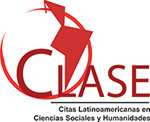Modeling, Simulation and Control of a Double Effect Evaporator as a Didactic Tool for Process Control
DOI:
https://doi.org/10.23857/dc.v8i2.2704Palabras clave:
modeling, simulation, didactics, processes.Resumen
The present research work models, simulates and controls a double effect evaporator as a didactic tool for the chair of process control through software. The mathematical modeling of the behavior of the double effect evaporator was carried out by means of mass and energy balances for the first and second effect, obtaining the respective differential equations, which are entered in a model in Simulink. In addition, to meet the set control objectives, it was necessary to control the variables concentration of the product (Xp), accumulation in the first effect and second effect (M1 - M2) so that they remain below or at the set point. The creation of the didactic interface was developed from the basic components of the Matlab application "App Designer", including commands within the code lines so that there is interaction between the Simulink model and the interface created. This command is processed by the Simulink Compiler and was packaged as a separate application thanks to Matlab Compiler. As a result, a graphical interface that operates independently was obtained, where the different adjustment values (SET-POINTS) can be defined. The mathematical model used for the simulation was validated with the article "Simulation and Control of a Commercial Double Effect Evaporator: Tomato Juice" presented by Yadav & Jana (2010) whose results show setpoint values of: 0.2609 kg solute / kg solution for the product concentration and 2268 kg for accumulation in the first effect. Comparing these results with the present work, the following data were obtained: 0.26067 kg solute / kg, and 2268.07 kg respectively, showing a relative percentage error of 0.088% and -0.003% respectively, being acceptable error values.
Citas
í…strí¶m, K. J., & Kumar, P. R. (2014). Survey Paper Control: A perspective ✩. Automática, 50, 3-43. https://doi.org/10.1016/j.automatica.2013.10.012
Dunn, Stanley M, Constantinides, Alkis y Moghe, & Prabhas V. (2006). Appendix B - Introduction to Simulink. In S. M. DUNN, A. CONSTANTINIDES, & P. v MOGHE (Eds.), Numerical Methods in Biomedical Engineering (pp. 487–516). Academic Press. https://doi.org/https://doi.org/10.1016/B978-012186031-8/50012-1
García Morilla, F. (2006). CONTROLADORES PID (AJUSTE EMPIRICO). http://www.dia.uned.es/~fmorilla/MaterialDidactico/ajuste_empirico.pdf
Hackett, B. W. (2018). The Essentials of Continuous Evaporation. Chemical Engineering Progress, 114(5), 24–28.
Komulainen, T. M., Enemark-Rasmussen, R., Sin, G., Fletcher, J. P., & Cameron, D. (2012). Experiences on dynamic simulation software in chemical engineering education. Education for Chemical Engineers, 7(4), e153–e162. https://doi.org/10.1016/J.ECE.2012.07.003
Luyben, W. L. (2018). Dynamic simulation of multi-effect evaporators. Chemical Engineering and Processing - Process Intensification, 131, 106–115. https://doi.org/10.1016/J.CEP.2018.07.005
McCabe, W. L., Smith, J. C., & Harriott, P. (1991). Operaciones unitarias en ingeniería química (4th ed.). McGraw-Hill. https://ingenieriapetroquimicaunefazulia.files.wordpress.com/2011/05/operaciones-unitarias-a.pdf
Miranda, V., & Simpson, R. (2005). Modelling and simulation of an industrial multiple effect evaporator: Tomato concentrate. Journal of Food Engineering, 66(2), 203–210. https://doi.org/10.1016/j.jfoodeng.2004.03.007
Moodley, K. (2020). Improvement of the learning and assessment of the practical component of a Process Dynamics and Control course for fourth year chemical engineering students. Education for Chemical Engineers, 31, 1–10. https://doi.org/10.1016/J.ECE.2020.02.002
Runyon, C. H., Rurnsey, T. R., & Mccarthy, K. L. (1991). Dynamic Simulation of a Nonlinear Model of a Double Effect Evaporator. In Journal ofFood Engineering (Vol. 14).
Smith, C., & Corripio, A. (2014). Control automático de procesos.
Verma, O. P., Manik, G., & Mohammed, T. H. (2017). Energy management in multi stage evaporator through a steady and dynamic state analysis. Korean Journal of Chemical Engineering, 34(10), 2570–2583.
Verma, O. P., Mohammed, T. H., Mangal, S., & Manik, G. (2018). Modeling, simulation and control of the dynamics of a Heptads’ effect evaporator system used in the Kraft recovery processes. Transactions of the Institute of Measurement and Control, 40(7), 2278–2290.
Yadav, P., & Jana, A. K. (2010). Simulation and control of a commercial double effect evaporator. Chemical Product and Process Modeling, 5(1). https://doi.org/10.4067/S0718-07642004000400014
Publicado
Cómo citar
Número
Sección
Licencia
Authors retain copyright and guarantee the Journal the right to be the first publication of the work. These are covered by a Creative Commons (CC BY-NC-ND 4.0) license that allows others to share the work with an acknowledgment of the work authorship and the initial publication in this journal.






